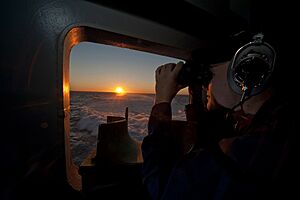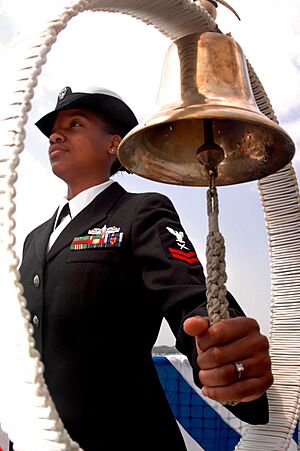Watchkeeping facts for kids
Watchkeeping or watchstanding is when sailors are given special jobs on a ship. These jobs help operate the ship all the time, day and night. These tasks are called watches. They are super important for keeping the ship safe and ready for any emergency. People who work during a watch are called watchkeepers.
On a ship, whether it's a navy ship or a cargo ship, crew members "keep a watch" in different places. For example, they might be on the bridge (where the ship is steered) or in the engine room. On the bridge, a lookout watches for other ships or dangers. A deck officer makes sure the ship is going the right way. In the engine room, an engine officer checks that all the machines are working correctly.
Contents
What are the Different Kinds of Watches?
Ships have many types of watches because they have different needs. Here are some common ones:
These watches help steer the ship and keep it safe.
- Officers: These are the leaders. They include the Officer of the deck who is in charge of the bridge.
- Enlisted Sailors: These sailors help the officers. They include the Helmsman who steers the ship. A Lookout watches for anything important outside the ship.
Engineering Watches
These watches make sure the ship's engines and other systems work well.
- Officers: The Engineering officer of the watch leads this team.
- Enlisted Sailors: They check things like the Boiler and electrical systems. They also help with damage control if something breaks.
Security Watches
These watches keep the ship and its crew safe from threats.
- Petty officer of the watch: This person is in charge of security.
- Gangway watch: They control who comes on and off the ship.
- Sentry: These are guards who protect specific areas.
Communication Watches
These watches handle all messages coming to and from the ship.
- Radio watch: They listen for and send radio messages.
- Signal bridge watches: They use flags or lights to send signals.
Combat Watches
These watches are specific to navy ships and are active during battles or drills.
- Tactical action officer: This officer makes important decisions during combat.
- Combat information center watch officer: They manage information about what's happening around the ship.
Other Important Watches
- Anchor watch: This watch makes sure the anchor is holding the ship in place when it's stopped.
- Cargo watch: On merchant ships, this watch looks after the cargo.
- Fire watch: These sailors are ready to put out fires.
How Do Watch Systems Work?
A watch system is a plan for how crew members take turns working. It makes sure the ship is always running 24 hours a day. It also gives everyone enough time to rest.
The length of watches can change depending on the ship. Some systems make sure different teams work at night. Other systems have the same team work at the same times every day.
Many watch systems use something called a dog watch. This is when one watch period is split into two shorter ones. This helps the crew have a different schedule each day. Dog watches are often set around dinner time so everyone can eat easily.
Traditional Watch System
This system was used on old sailing ships and by the Royal Navy. It has five four-hour watches and two two-hour watches. The crew is usually split into two groups, like "Team 1" and "Team 2". This system helps them take turns working.
| Name | Time | Day 1 | Day 2 | Day 3 |
|---|---|---|---|---|
| First watch | 2000–0000 | Team 1 | Team 2 | Team 1 |
| Middle watch | 0000–0400 | Team 2 | Team 1 | Team 2 |
| Morning watch | 0400–0800 | Team 1 | Team 2 | Team 1 |
| Forenoon watch | 0800–1200 | Team 2 | Team 1 | Team 2 |
| Afternoon watch | 1200–1600 | Team 1 | Team 2 | Team 1 |
| First dog watch | 1600–1800 | Team 2 | Team 1 | Team 2 |
| Second dog watch | 1800–2000 | Team 1 | Team 2 | Team 1 |
Traditional System with Three Teams
This system uses the same watch times but divides the crew into three teams instead of two. This means each sailor gets more time off to rest, sometimes over seven hours of sleep! The teams might be called "Team 1," "Team 2," and "Team 3."
| Name | Time | Day 1 | Day 2 | Day 3 |
|---|---|---|---|---|
| First watch | 2000–0000 | Team 1 | Team 2 | Team 3 |
| Middle watch | 0000–0400 | Team 2 | Team 3 | Team 1 |
| Morning watch | 0400–0800 | Team 3 | Team 1 | Team 2 |
| Forenoon watch | 0800–1200 | Team 1 | Team 2 | Team 3 |
| Afternoon watch | 1200–1600 | Team 2 | Team 3 | Team 1 |
| First dog watch | 1600–1800 | Team 3 | Team 1 | Team 2 |
| Last dog watch | 1800–2000 | Team 1 | Team 2 | Team 3 |
Six-Hour Shift System
This system divides the day into four six-hour watches. This allows a three-team crew to get the most rest over three days. It also helps with meal times. The team starting their watch eats first, then works. The team finishing their watch eats after they are done.
| Day 1 | Day 2 | Day 3 | |
|---|---|---|---|
| 0100–0700 | Team Blue | Team Gold | Team White |
| 0700–1300 | Team Gold | Team White | Team Blue |
| 1300–1900 | Team White | Team Blue | Team Gold |
| 1900–0100 | Team Blue | Team Gold | Team White |
US Submarine System (Three Teams)
On United States submarines, the crew is usually split into three teams. Each team works for 8 hours and then gets 16 hours off. This schedule is fairly new. Before 2015, submariners worked 6 hours on and 12 hours off. The 12 hours off were split into 6 hours for cleaning and fun, and 6 hours for sleeping.
| Name | Time | Day 1 | Day 2 | Day 3 |
|---|---|---|---|---|
| Mid watch | 2330–0530 | Team 1 | Team 2 | Team 3 |
| Morning watch | 0530–1130 | Team 2 | Team 3 | Team 1 |
| Afternoon watch | 1130–1730 | Team 3 | Team 1 | Team 2 |
| Evening watch | 1730–2330 | Team 1 | Team 2 | Team 3 |
One-in-Two Watch System
Some warships use this system, also called "7s and 5s." This means sailors get longer sleep periods than with the traditional two-team system. It still allows the ship to work properly. Meals are usually planned around the times watches change.
| Day 1 | Day 2 | Day 3 | |
|---|---|---|---|
| 0000–0700 | Team 1 | Team 1 | Team 1 |
| 0700–1200 | Team 2 | Team 2 | Team 2 |
| 1200–1700 | Team 1 | Team 1 | Team 1 |
| 1700–0000 | Team 2 | Team 2 | Team 2 |
Merchant Ship Watch System
On merchant ships, watchkeepers usually work for six periods of four hours each. This system is easy to remember and stays the same every day. For example, a sailor on "Team 1" knows they work from 4 a.m. to 8 a.m. and 4 p.m. to 8 p.m. This system also lets less experienced watchkeepers work when senior officers are likely awake to help.
| Day 1 | Day 2 | Day 3 | |
|---|---|---|---|
| 0400–0800 | Team 1 | Team 1 | Team 1 |
| 0800–1200 | Team 2 | Team 2 | Team 2 |
| 1200–1600 | Team 3 | Team 3 | Team 3 |
| 1600–2000 | Team 1 | Team 1 | Team 1 |
| 2000–0000 | Team 2 | Team 2 | Team 2 |
| 0000–0400 | Team 3 | Team 3 | Team 3 |
Ship's Bell: Telling Time at Sea
A ship's bell is used to tell the time on a ship. It helps sailors know when to change watches. Unlike regular clocks, the bell strikes don't match the hour number. Instead, there are eight bells for each four-hour watch. A bell is struck every half-hour. The strikes are often in pairs to make them easier to count.
See Also
- Duty officer
- Work shift



